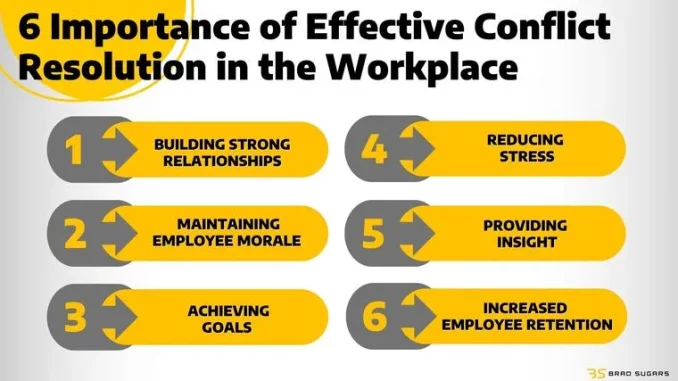
Conflicts are inevitable in any workplace. With a diverse range of personalities, communication styles, and work approaches, disagreements are bound to arise. However, how you handle these conflicts can make a significant difference in the overall health of your team and company. Proper conflict resolution can transform potential disruptions into opportunities for growth, improved collaboration, and stronger relationships.
Here are practical tips to manage and resolve workplace conflicts effectively.
1. Acknowledge the Conflict Early
One of the most common mistakes in conflict management is ignoring or avoiding the issue. Small disagreements, if left unresolved, can escalate into bigger problems. It’s crucial to address conflicts as soon as they arise, even if they seem minor at first. Acknowledging the issue early prevents resentment from building up and encourages a more open dialogue between the involved parties.
-
Look for signs of conflict: Pay attention to signs of tension—whether it’s passive-aggressive behavior, withdrawal, or open arguments. Being proactive helps to resolve issues before they worsen.
-
Create a safe space for discussion: Let employees know that it’s safe to talk about issues without fear of judgment or retaliation. This encourages openness and reduces the emotional intensity of the conflict.
2. Stay Calm and Objective
When involved in a conflict, it’s easy to get emotionally charged. However, for effective conflict resolution, it’s important to remain calm and objective. Reacting impulsively or taking sides can escalate the situation further.
-
Control your emotions: Take a moment to collect your thoughts before responding. This ensures you don’t say something you might regret and helps you stay focused on the issue at hand.
-
Separate emotions from facts: Stick to the facts of the situation and avoid personal attacks. Frame the conversation around resolving the problem, not assigning blame.
Remaining calm helps to de-escalate tension and shows that you are a fair mediator, not someone adding to the conflict.
3. Listen Actively
In any conflict, each party has their perspective, and understanding both sides is essential for resolution. Active listening is a critical skill in conflict resolution, as it helps you grasp the underlying issues, which may not always be immediately obvious.
-
Give full attention: Show that you’re listening by making eye contact, nodding, and avoiding distractions like checking your phone or computer.
-
Validate their feelings: Acknowledge the emotions of those involved. For instance, saying, “I understand why you’re frustrated,” can help the person feel heard and valued.
-
Ask clarifying questions: Instead of jumping to conclusions, ask open-ended questions to get a clearer picture of the issue. This shows you’re interested in resolving the problem, not just taking sides.
By listening actively, you create an environment where all parties feel understood, which can reduce hostility and pave the way for a more constructive conversation.
4. Encourage Empathy and Collaboration
Often, conflicts arise due to misunderstandings or miscommunications. Encouraging empathy can help individuals see the issue from the other person’s point of view and realize that their feelings and experiences are valid.
-
Encourage open dialogue: Invite both parties to share their perspectives in a calm and respectful manner. Encourage them to use “I” statements (e.g., “I feel…”) rather than blaming the other person.
-
Look for common ground: In many conflicts, there is a shared goal or interest, even if it’s not immediately apparent. Identifying this common ground can serve as the foundation for finding a mutually agreeable solution.
-
Work towards a solution: Instead of focusing on who’s right or wrong, encourage collaboration in finding a solution. Guide the conversation toward how both parties can move forward together.
Empathy and collaboration not only resolve conflicts but also strengthen relationships and teamwork.
5. Set Clear Expectations and Boundaries
Once the conflict has been discussed and a solution agreed upon, it’s important to set clear expectations for how to move forward. This prevents future misunderstandings and ensures that the resolution is implemented.
-
Define specific actions: Clearly outline what each person needs to do to prevent similar conflicts in the future. This may include changes in communication styles, task delegation, or adjustments in behavior.
-
Establish boundaries: Make it clear what’s acceptable behavior and what’s not. Set expectations for how team members should interact with each other moving forward, emphasizing respect and professionalism.
-
Follow up: After some time, check in with the parties involved to ensure the solution is working and that the conflict hasn’t resurfaced. This shows that you’re committed to maintaining a harmonious workplace.
Clear expectations and boundaries prevent confusion and foster an environment of accountability, ensuring long-term success in resolving conflicts.
6. Promote a Positive Work Environment
Preventing conflicts from arising in the first place is as important as resolving them. By fostering a positive work culture that emphasizes respect, communication, and teamwork, you reduce the likelihood of conflicts.
-
Encourage team-building: Organize team-building activities that allow employees to get to know one another and improve communication and trust.
-
Set a positive example: As a leader, model positive conflict resolution behaviors. Show your team how to handle disagreements respectfully and professionally.
-
Offer conflict resolution training: Provide your team with the tools they need to manage conflicts on their own. Training programs can teach valuable communication skills, stress management, and problem-solving techniques.
A positive workplace culture minimizes conflicts and ensures that employees feel valued, reducing the chances of issues spiraling out of control.
Conclusion
Conflict is a natural part of any workplace, but how it’s handled can determine its impact. By acknowledging the issue early, staying calm, listening actively, encouraging empathy, and setting clear expectations, you can turn conflicts into opportunities for growth and improvement. As a leader, promoting a positive work environment and providing the right tools for conflict resolution ensures that your team can handle disagreements professionally and constructively. This ultimately leads to a more harmonious, productive, and engaged workplace.